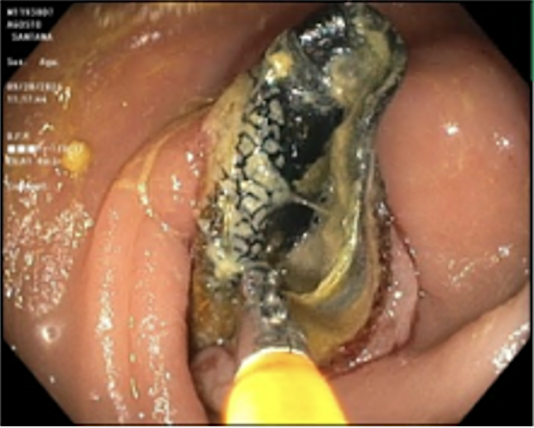Monday Poster Session
Category: General Endoscopy
P3009 - From Mesh to Morbidity: Endoscopic and Surgical Interventions for Cecal Erosion and Severe Complications Post-Hernia Repair
Monday, October 27, 2025
10:30 AM - 4:00 PM PDT
Location: Exhibit Hall
- QA
Qusai Almasad, MD
Roger Williams Medical Center
Providence, RI
Presenting Author(s)
Qusai AlMasad, MD1, Paola Pena, MD1, Aryanna Sousa, MD, MPH1, Iskandarova Aygul, MD2, Nabil Toubia, MD, MPH2
1Roger Williams Medical Center, Providence, RI; 2Roger Williams Medical center, Providence, RI
Introduction: The use of synthetic mesh in hernia repair is a common surgical practice, offering strength and reducing recurrence rates. However, mesh erosion into adjacent organs is a rare but serious complication that can lead to significant morbidity. This case report presents a 60-year-old female with a history of multiple abdominal surgeries, who developed mesh erosion into the cecum, leading to a cascade of complications requiring extensive surgical management.
Case Description/
Methods: The patient is a 60-year-old female with multiple abdominal surgeries including appendectomy, cholecystectomy, right lower abdominal hernia mesh repair. Presented to the emergency department with lower abdominal pain, a CT scan riveild a susspecious for an abscess in the right lower quadrant abutting the cecal tip, raising the possibility of stump appendicitis. A subsequent colonoscopy identified a foreign body in the cecum, which appeared to pierce the cecal wall, most likely representing abdominal wall mesh eroding into the lumen. The patient underwent laparoscopic right hemicolectomy, abscess drainage, mesh removal, and hernia repair. Post-operatively, she developed a colonic leak and recurrent pain, leading to abscess drainage by interventional radiology. A colocutaneous fistula was diagnosed, necessitating an open takedown of the fistula, resection, and new ileocolostomy creation. She was later discharged to a skilled nursing facility for recovery.
Discussion: Mesh erosion into the gastrointestinal tract, as seen in this patient, presents a significant challenge. While synthetic mesh is effective in hernia repairs, rare complications like erosion are clinically significant. This case underscores the diagnostic difficulties of mesh erosion, initially mimicking stump appendicitis. Advanced imaging and endoscopy were vital in identifying the eroded mesh within the cecum, highlighting the need to consider mesh-related issues in patients with prior hernia repairs and gastrointestinal symptoms.
Conclusion
This case highlights the complexity of mesh erosion into the gastrointestinal tract, especially in patients with multiple abdominal surgeries. Gastroenterologists should be vigilant for mesh-related complications in patients with unusual abdominal symptoms post-hernia repair. Effective management requires comprehensive diagnostics and a multidisciplinary approach. The case underscores the need for ongoing research into safer surgical materials and techniques to reduce these risks and enhance outcomes in hernia repairs.

Figure: Abdominal wall mesh piercing the cecal wall
Disclosures:
Qusai AlMasad indicated no relevant financial relationships.
Paola Pena indicated no relevant financial relationships.
Aryanna Sousa indicated no relevant financial relationships.
Iskandarova Aygul indicated no relevant financial relationships.
Nabil Toubia indicated no relevant financial relationships.
Qusai AlMasad, MD1, Paola Pena, MD1, Aryanna Sousa, MD, MPH1, Iskandarova Aygul, MD2, Nabil Toubia, MD, MPH2. P3009 - From Mesh to Morbidity: Endoscopic and Surgical Interventions for Cecal Erosion and Severe Complications Post-Hernia Repair, ACG 2025 Annual Scientific Meeting Abstracts. Phoenix, AZ: American College of Gastroenterology.
1Roger Williams Medical Center, Providence, RI; 2Roger Williams Medical center, Providence, RI
Introduction: The use of synthetic mesh in hernia repair is a common surgical practice, offering strength and reducing recurrence rates. However, mesh erosion into adjacent organs is a rare but serious complication that can lead to significant morbidity. This case report presents a 60-year-old female with a history of multiple abdominal surgeries, who developed mesh erosion into the cecum, leading to a cascade of complications requiring extensive surgical management.
Case Description/
Methods: The patient is a 60-year-old female with multiple abdominal surgeries including appendectomy, cholecystectomy, right lower abdominal hernia mesh repair. Presented to the emergency department with lower abdominal pain, a CT scan riveild a susspecious for an abscess in the right lower quadrant abutting the cecal tip, raising the possibility of stump appendicitis. A subsequent colonoscopy identified a foreign body in the cecum, which appeared to pierce the cecal wall, most likely representing abdominal wall mesh eroding into the lumen. The patient underwent laparoscopic right hemicolectomy, abscess drainage, mesh removal, and hernia repair. Post-operatively, she developed a colonic leak and recurrent pain, leading to abscess drainage by interventional radiology. A colocutaneous fistula was diagnosed, necessitating an open takedown of the fistula, resection, and new ileocolostomy creation. She was later discharged to a skilled nursing facility for recovery.
Discussion: Mesh erosion into the gastrointestinal tract, as seen in this patient, presents a significant challenge. While synthetic mesh is effective in hernia repairs, rare complications like erosion are clinically significant. This case underscores the diagnostic difficulties of mesh erosion, initially mimicking stump appendicitis. Advanced imaging and endoscopy were vital in identifying the eroded mesh within the cecum, highlighting the need to consider mesh-related issues in patients with prior hernia repairs and gastrointestinal symptoms.
Conclusion
This case highlights the complexity of mesh erosion into the gastrointestinal tract, especially in patients with multiple abdominal surgeries. Gastroenterologists should be vigilant for mesh-related complications in patients with unusual abdominal symptoms post-hernia repair. Effective management requires comprehensive diagnostics and a multidisciplinary approach. The case underscores the need for ongoing research into safer surgical materials and techniques to reduce these risks and enhance outcomes in hernia repairs.

Figure: Abdominal wall mesh piercing the cecal wall
Disclosures:
Qusai AlMasad indicated no relevant financial relationships.
Paola Pena indicated no relevant financial relationships.
Aryanna Sousa indicated no relevant financial relationships.
Iskandarova Aygul indicated no relevant financial relationships.
Nabil Toubia indicated no relevant financial relationships.
Qusai AlMasad, MD1, Paola Pena, MD1, Aryanna Sousa, MD, MPH1, Iskandarova Aygul, MD2, Nabil Toubia, MD, MPH2. P3009 - From Mesh to Morbidity: Endoscopic and Surgical Interventions for Cecal Erosion and Severe Complications Post-Hernia Repair, ACG 2025 Annual Scientific Meeting Abstracts. Phoenix, AZ: American College of Gastroenterology.
